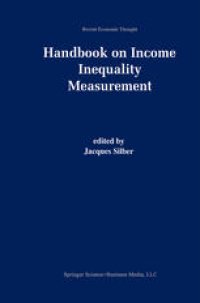
Ebook: Handbook of Income Inequality Measurement
- Tags: Methodology and the History of Economic Thought, Public Finance & Economics, Microeconomics
- Series: Recent Economic Thought Series 71
- Year: 1999
- Publisher: Springer Netherlands
- Edition: 1
- Language: English
- pdf
Amartya Sen "Equality," I spoke the word As if a wedding vow Ah, but I was so much older then, I am younger than that now. Thus sang Bob Dylan in 1964. Approbation of equality varies not only with our age (though it is not absolutely clear in which direction the values may shift over one's life time), but also with the spirit of the times. The 1960s were good years for singing in praise of equality. The spirit of the present times would probably be better reflected by melodies in admiration of the Federal Reserve System. And yet the technical literature on the evaluation and measurement of economic inequality has grown remarkably over the last three decades. Even as actual economic policies (especially in North America and Europe) have tended to move towards focusing on virtues other than the avoidance of economic inequality, the professional literature on assessing and gauging economic inequality has taken quite a jump forward. A great many different problems have been addressed and effectively sorted out, and new problems continue to be posed and analyzed. The Contents: A Review Jacques Silber has done a great service to the subject by producing this collection of admirablyhelpful and illuminating papers on different aspects of the measurement of income inequality. The reach of this collection is quite remarkable. Along with a thorough overview from the editor himself, the major areas in this complex field have been carefully examined and accessibly discussed.
The Handbook of Income Inequality Measurement emphasizes the theoretical foundations of the domain and its extensions and applications. Following a thorough overview of the main questions that have to be addressed explicitly or implicitly when making income inequality comparisons, the volume offers a historical survey of the link between the personal and functional distributions of incomes. The next chapters are devoted to a presentation of the theoretical basis of income inequality analysis and give an illuminating account of the normative, axiomatic and subjective approaches to this area and of its connections to the literature on stochastic dominance. Four studies then look at the statistical tools to be employed when assessing or ranking inequalities, whether the goal is to estimate inequality indices, derive parametric approximations to Lorenz curves or test the significance of the partial orderings that reflect Lorenz comparisons. The last nine chapters review specific issues in and applications of income inequality analysis. The subjects covered are the decomposition of inequality by income sources and population subgroups, the use of equivalence scales, multidimensional inequality, income tax progressivity, life-time income inequality, income mobility and the interrelations between inequality, welfare and poverty.